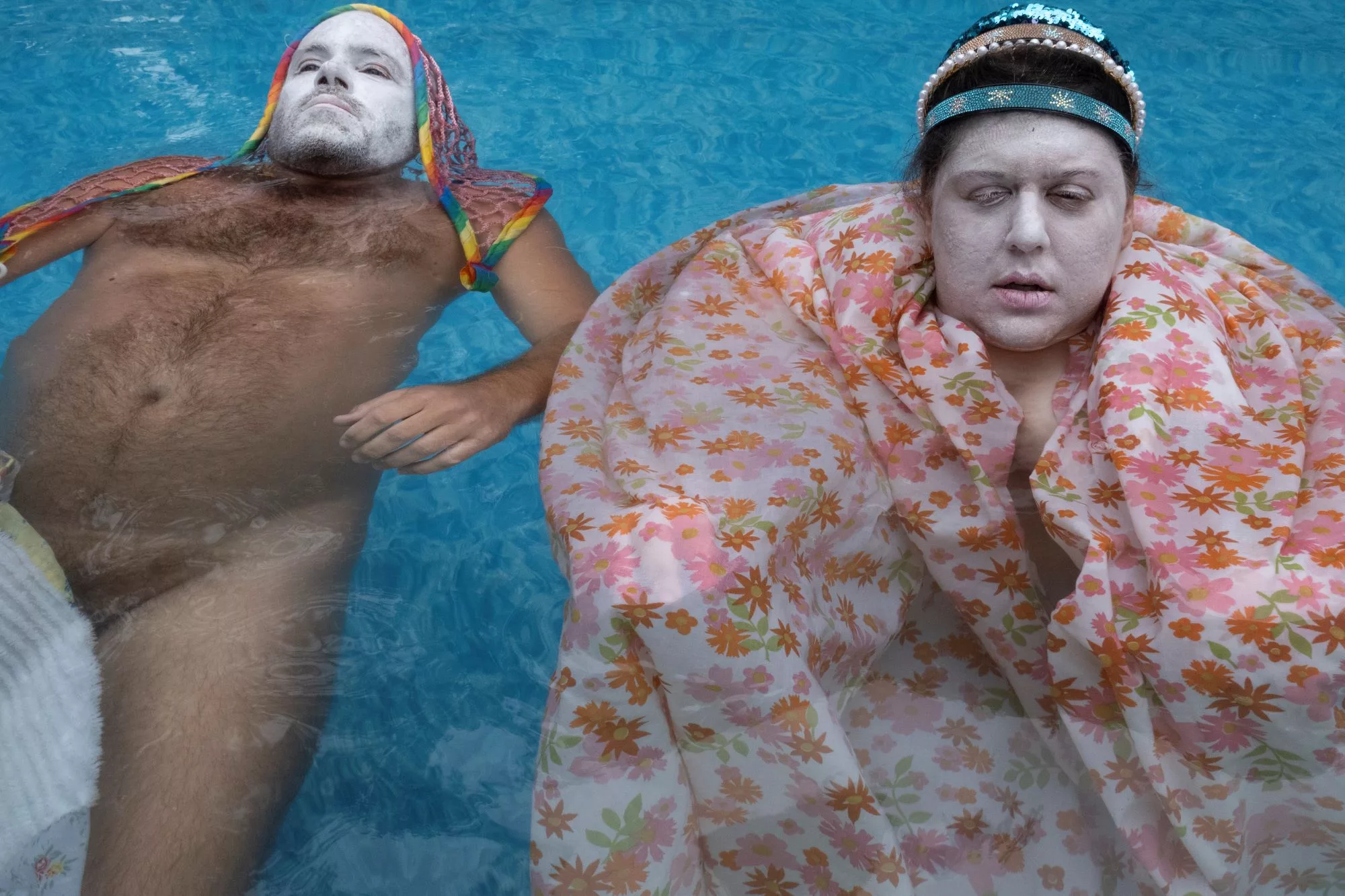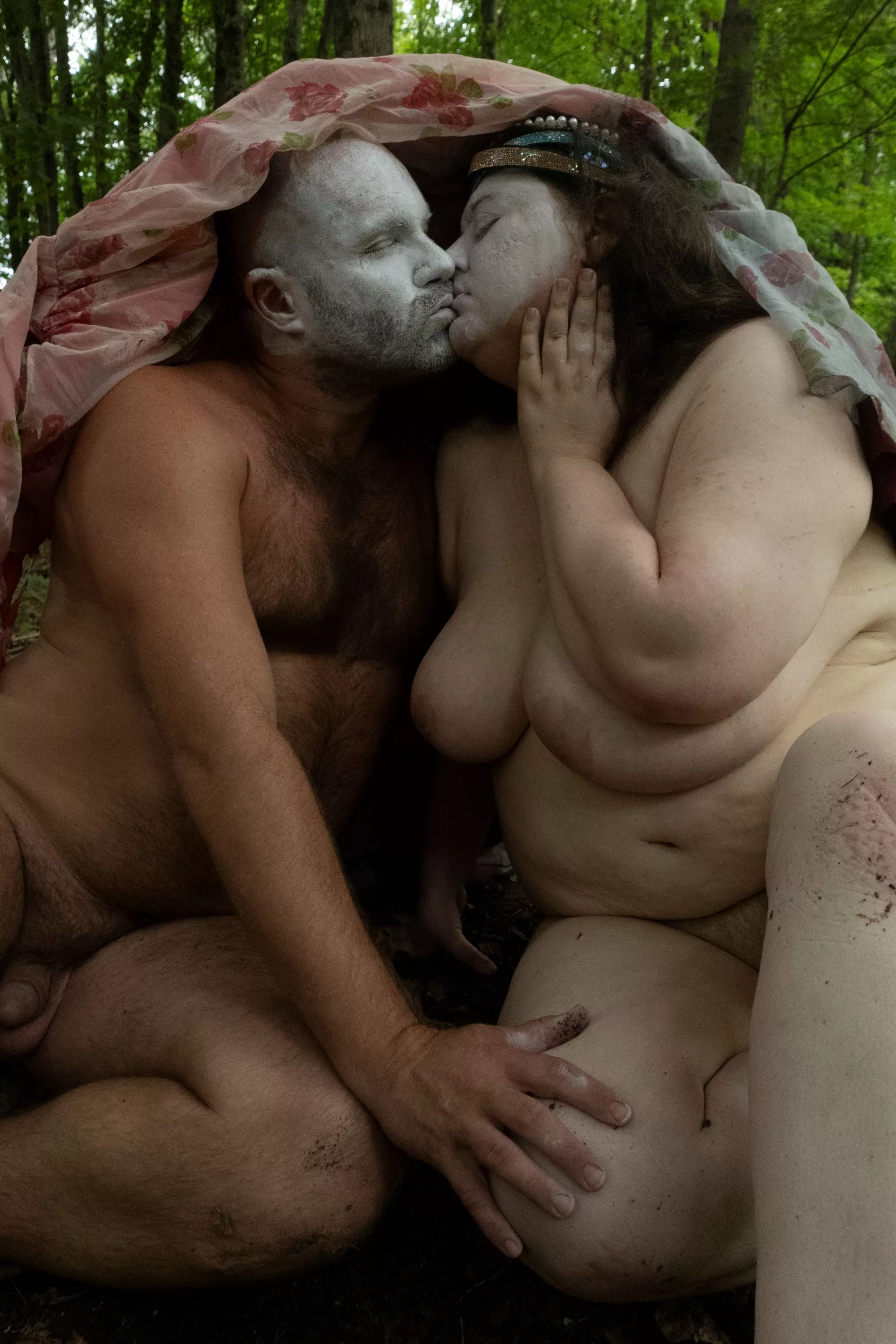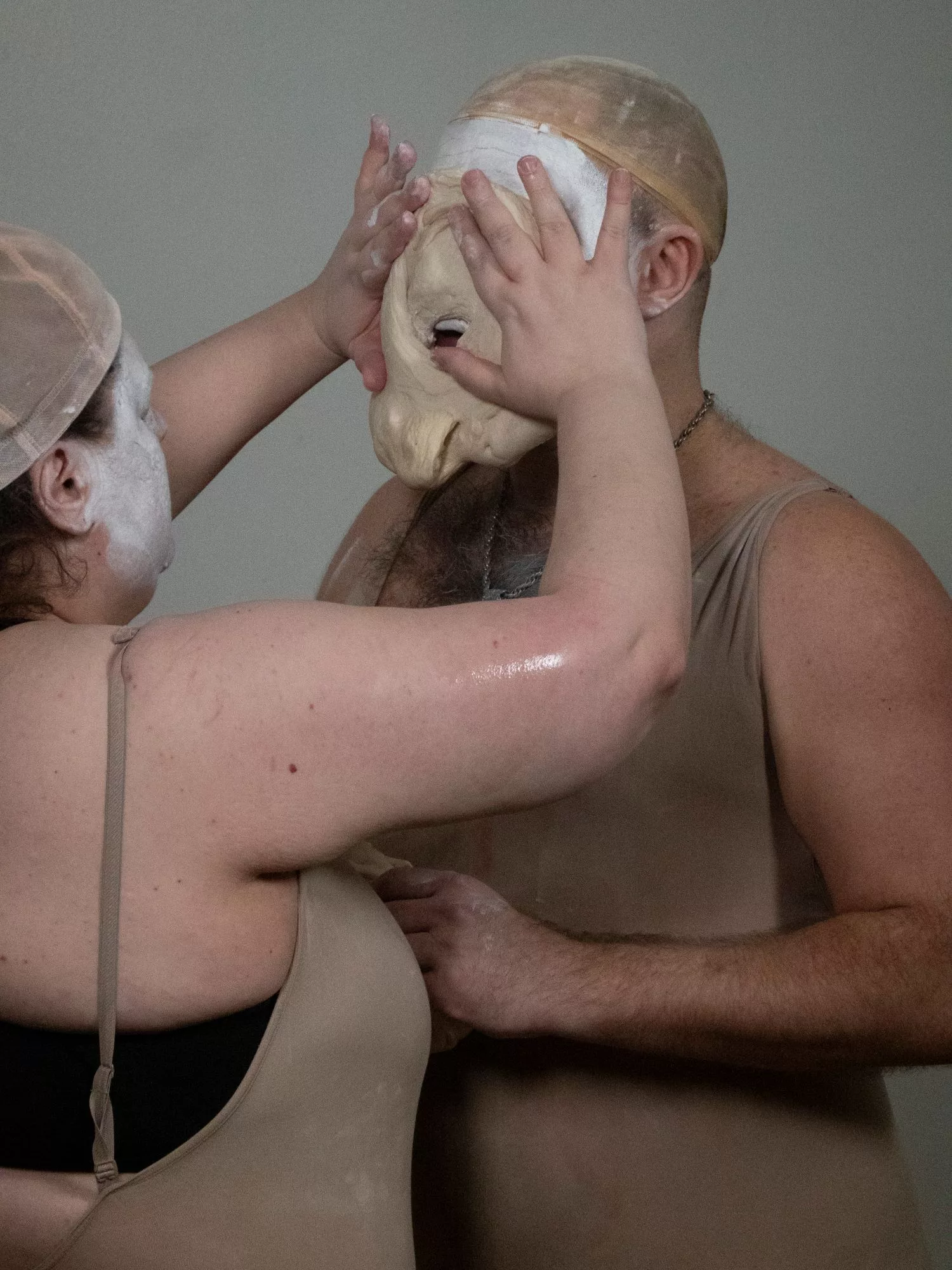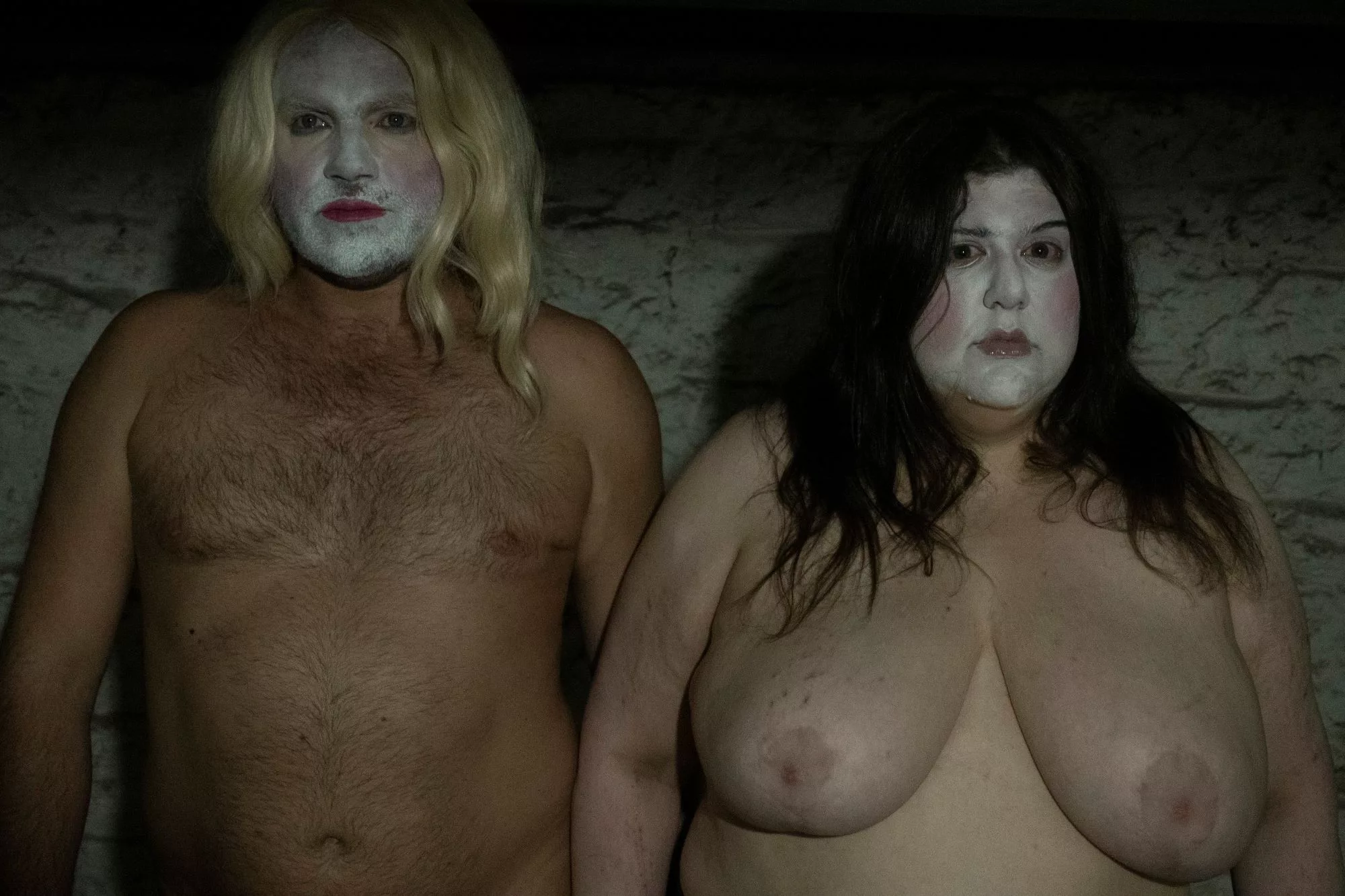Ann Liv Young has transformed her Brooklyn apartment into a theatre to present her latest performance piece. What happens on stage is sure to surprise.

It’s a Saturday night in New York, and Ann Liv Young’s Bushwick apartment has been transformed into a saloon-style theatre. Eight guests sit eagerly on small, mismatched stools in her kelly green kitchen. The reason for the gathering is Marie Antoinette, the performance artist and choreographer’s current piece, which is the equivalent of a perpetual trust fall.
The evening is part of a series that began as a one-off show last winter and has continued semi-regularly since. Young shares upcoming dates on her Instagram until the seats sell out. (The next show is May 18, and the artist is already planning a version at her home upstate this July). Every night is different—some shows are seated dinners while others are themed. Nothing is scripted, but scenes are set up: There’s the baby scene, the telephone scene, the dough scene, and the boat scene, among others. Emotions bubble to the surface, explode and pour over, sticky on the floor. A provocateur at heart, Young has little concern for the fourth wall; to say she breaks it would be an understatement.
“Emotions bubble to the surface, explode, and pour over sticky on the floor.”
Billed as a play within a play, the allegedly true stories of performers Alex Sabina and Tom Ruth provide a foundation for the plot. Then there is the titular historical drama of the hapless couple Marie Antoinette and King Louis XVI. “They both fantasise about being famous but are real-life marginalised citizens,” reads the press material on the two leads. “For them, performing in front of an audience is as much a fantasy as being king and queen.”
Ruth is described as a former soccer star and teacher who suffers from anxiety and paranoia, who “exists in perpetual conflict.” Sources of said conflict: his students, his colleagues at the school, a predatory landlord. Sabina’s bio is given as the following: “Her life is a mystery. She claims to have been a burlesque performer. She is obsessed with travel but doesn’t seem to have been outside of New York City.”

Tonight, Young is both director and host. She weaves through the seating and passes out cloth napkins. Later, there are bear-claw pastries and cupcakes. The artists Quori Theodor and Bobbi Salvör Menuez sit to my right. Two guests who purchased a premium dinner package are led to a small table near the front. A woman who has seen this play three times already sits behind me. Everyone seems to have some connection to the art and performance scenes. A small hairless kitten skirts around our legs while a small dog leaps up and nestles into someone’s lap. Young’s partner, Nick Strini, assumes his position in the kitchen to film the entire play. Her 16-year-old daughter Lovie, dressed in custom Marie Antoinette merch, leads the final guest inside before pulling up a stool.
“If Ruth or Sabina feel they are pushed beyond what they can handle, they can opt-out whenever they want, she reassures us.”
The performance begins with an opening monologue. Young stands before us, her tousled brown hair hanging down over a loose sand-coloured, long-sleeved dress. Monochrome Crocs peek out from the bottom. Her face is moon-like—round and bright but stony, animated yet unyielding. For a few minutes, I fixate on her expressions, hoping to decipher some sign of irony or earnestness as she tells us the story of how her allegedly mentally ill, amateur leads—Ruth and Sabina—came to play their respective roles. We should be prepared for outbursts and jealousy between the two castmates, says Young. Is she serious? I make a mental note to circle back and decide, for the sake of the experience, to trust her.
Earlier this year, the artist summed up the premise of her show as: “I’m saying these people are mentally ill, and she’s saying that she isn’t,” in an interview with BOMB. This tension hovers above every scene: the dynamic between director and actor, the power play and the relinquishment of agency outside of the role. Trust.
The roles are both physically and mentally taxing. If Ruth or Sabina feel they are pushed beyond what they can handle, they can opt-out whenever they want, Young reassures us, adding that the play has come to a halt for such reasons in the past.

While Young is talking from the living room-turned-stage, Ruth and Sabina are presumably out of earshot behind the closed bedroom door behind her. Or so Young implies as she confides in us the various trials and tribulations she has undergone to coax the forthcoming performances out of the duo. (Sabina, she explains, has agoraphobia and is neurotic; she reminds Young of her own mother). And the work is not done, as Young tells and later shows by directing as the play unfolds.
Soon Ruth (on a stool) and Sabina (directly in front of him) appear, one after the other at arm’s length from the closest seats. Following Young’s prompting, they each tell us what is on their mind: a mix of ongoing and new familial trauma. The audience gives their support; people relate.
Ruth and Sabina’s bodies spill out of sheer nude body stockings and caps. The former sports a single riding glove and an oversized gold cross with an orange stone in the centre. Faces painted white, they behave unpredictably, just as Young predicted. Yet they also obey every command, stopping and restarting lines to give the director her desired performance. Sometimes Young pauses to ask us for our feedback.
“Is she serious? I make a mental note to circle back and decide, for the sake of the experience, to trust her.”
Early on, Young also introduces two supporting characters, Stephen Donovan and Megan Sipe, as the “nurses” on set to purportedly assist Sabina and Ruth. They fluctuate between participating, co-directing, and standing calmly off to the side. Donovan also films a good portion of the performances up close on his iPhone.
During the first scene, Sabina wails out an abrasive karaoke rendition of Timbaland’s Apologize featuring OneRepublic. Ruth gyrates his body and pumps his arms behind her from atop the stool while Young, chewing gum and staring intently at her pupil, holds a boombox up to one side of Sabina’s head. Donovan holds his iPhone up to the other side. The kitten runs on stage and climbs up the leg of Sipe who is peacefully swaying to the chaotic music in the back. In a later scene, the two leads recite historical facts about the king and queen at rapid-fire as Young beats a drum at a frenetic pace. There is certainly something cathartic about Young’s Marie Antoinette, even as it progresses into more uncomfortable waters as the night goes on.

Sure, the cast is made up of actors, but what is fact and what is fiction? When are they in character, and when are they simply reaching from within and projecting what they find onto the stage?
On Young’s website, a video shows a therapy session in preparation of the performance. Ruth and Sabin unpack their grievances about a past walk in the rain as Young coaches and redirects off-camera. At one point, Sabina addresses Ruth: “I think you make excuses not to be in the moment. I think you make excuses not to confront your feelings, and I think you make excuses not to be vulnerable,” she tells him, exasperated. “Who’s you? King or me, Tom Ruth?” he responds. “We’re doing the queen, but I’m being honest,” she answers.”
There is plenty of time dedicated to tales of personal family histories on stage, too. For the final act, Young tells a dark childhood tale that involves a boat and alludes to domestic violence. She climbs atop a fractured boat’s bow, flanked by Sabina and Ruth, and begins to sing along to Christopher Cross’ 1979 soft rock ballad Sailing. Her body sways as Donovan uses his full force to rock the boat underneath her feet. Sipe reaches out an arm to balance her.
“The way Young sees it, she has never taken it too far. Push back? That only makes her stronger.”
Each time Young falls and propels herself back up with nimble and athletic ease, I am reminded that she is a trained dancer. I am also reminded of her legendary and subversive past feats of endurance. “Well, it’s not far back to sanity, at least it’s not for me,” Young belts as she is thrust around. “And if the wind is right you can sail away, and find serenity.”
After the show ends, I comb through an assortment of jewelled brooches and costume jewellery from past shows strewn across a table in the kitchen. Nearby, a painting of Sabina as Antoinette is affixed to the refrigerator, and T-shirts are hanging on the wall. In classic Young fashion, everything is for sale and everything—everyone—is part of the show.

Since she burst on the scene in the early 2000s, the artist has made a name for herself with her transgressive and temporal performances that are of myth-making proportions. Breast milk squirted from the stage. A mermaid spitting fish into the crowd. Audience interrogation. Karaoke renditions to chart toppers by the likes of Eminem, Mariah Carey, Kanye West. Masturbation, blood, shit, mid-performance confrontations, nudity.
She has shut herself in a self-imposed jell cell on a stage for days. Smeared shit across a volunteer’s T-shirt. As her alter, drag-like ego, Sherry (loosely based on her own mother) offers her own brand of boundary-pushing therapy. She once staged Antigone in her Bushwick apartment. She has reinterpreted canon stories from Anne Frank to Cinderella to Sophocles’ Electra and now to the French monarchy.
An expert at crowd work, her audience has been implicated a hundred times over. The way Young sees it, she has never taken it too far. Push back? That only makes her stronger. And she will always have the last word.

Beneath the shock-value, performances often provoke disturbing questions about real-world problems such as mental illness, financial struggles, and relationships. “It’s not fun to poop on stage in front of an audience. It’s not the easiest thing to do. People just assume that it’s for shock value,” she once succinctly put it. (She grew up with her mother using a colostomy bag). But yet she persists, using fiction to get at the heart of ineffable truths.
Young’s lived experiences are expelled and propelled forward to uncharted territories in performance. She grew up in North Carolina, where Southern sensibilities were oppressive and dark truths lurked under the surface. Her early childhood memories include sitting at Alcoholics Anonymous meetings and waiting in the lobby of the therapist’s office. The biographical threads poke out at the seams, but she is the one pulling the strings.
To define Young is a slippery slope, as she is always courting the inverse. A dance of contradictions is choreographed to tales both strange and immediately recognisable: visceral, confrontational, ethically ambiguous, entertaining, limit-pushing. Manipulative, maybe. Vulnerable, always. Say what you want, Young is a strong actress. And the curtain is always up.

Written by Meka Boyle





